LA-ICP-MS Trace Element Composition of Sphalerite and Galena of the Proterozoic Carbonate-Hosted Morro Agudo Zn-Pb Sulfide District, Brazil: Insights into Ore Genesis
Abstract
:1. Introduction
2. Geological Setting and Metallogeny of the Vazante Group

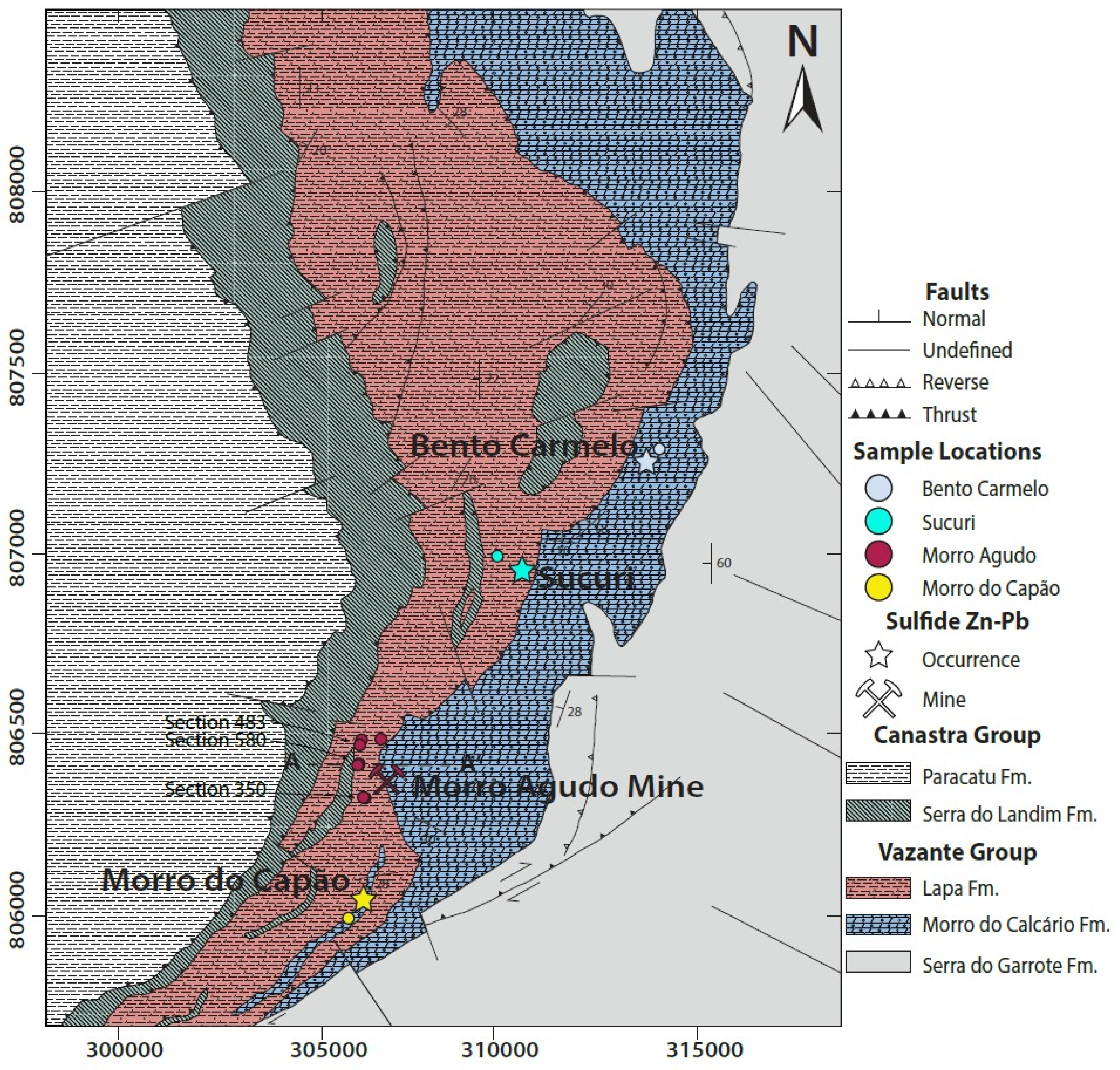
2.1. Morro Agudo District
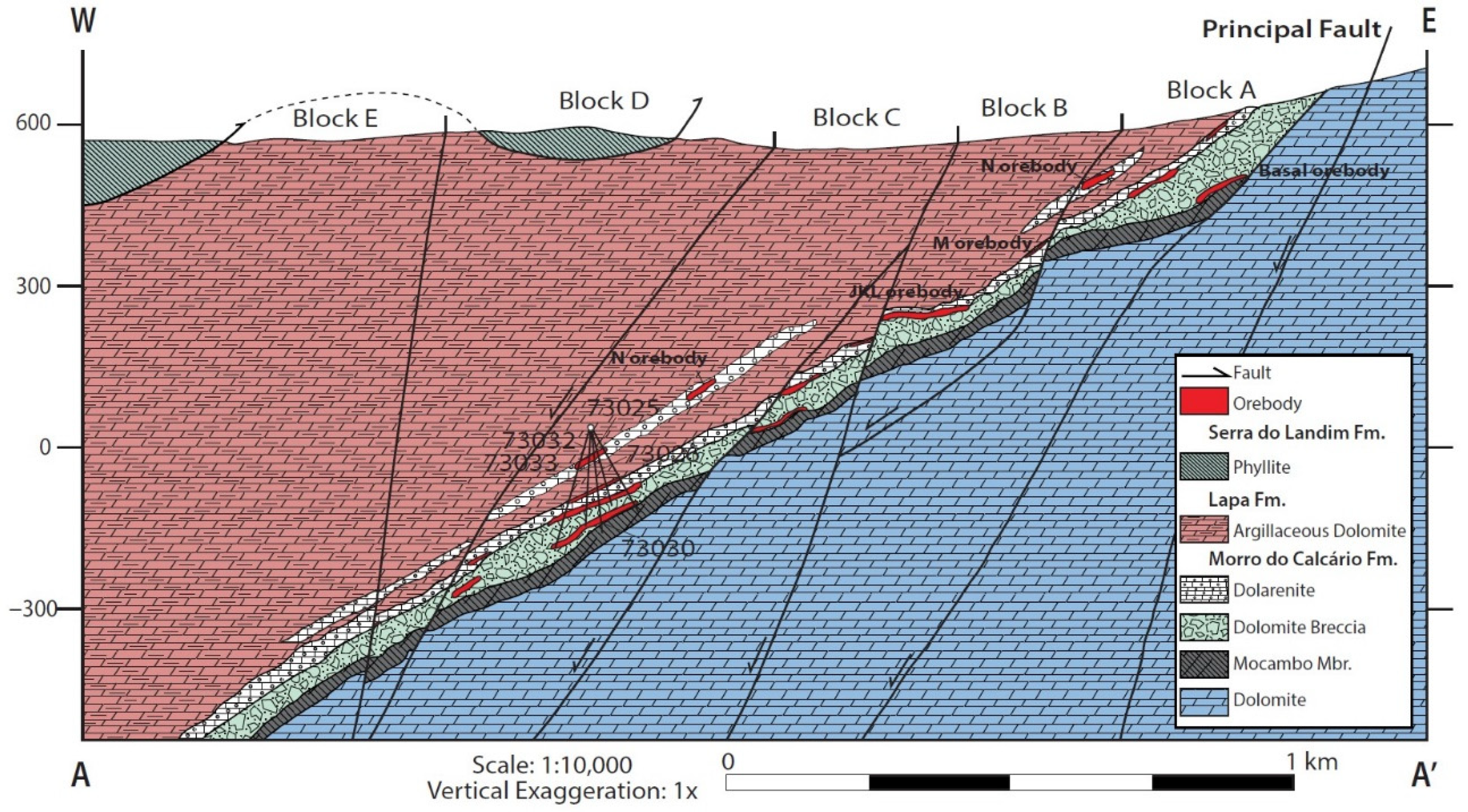
Ore Mineral Textures, Compositions and Associated Hydrothermal Alteration of the Morro Agudo District

3. Methodology
3.1. Sampling
3.2. Laser-Ablation Inductively Coupled Plasma Mass-Spectrometry (LA-ICP-MS)
3.3. Data Treatment and Principal Component Analysis
4. Results
4.1. Sphalerite Trace Element Content
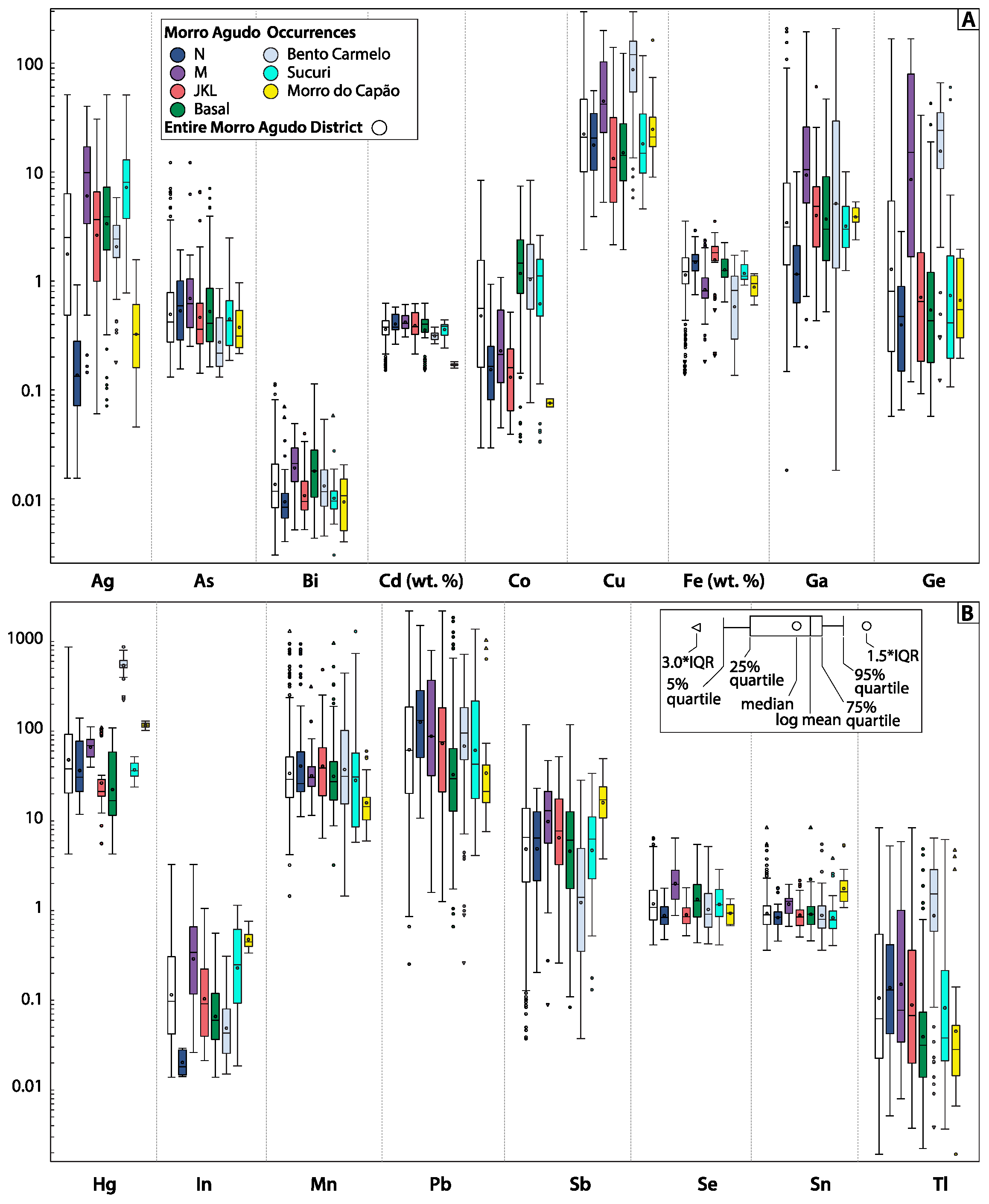
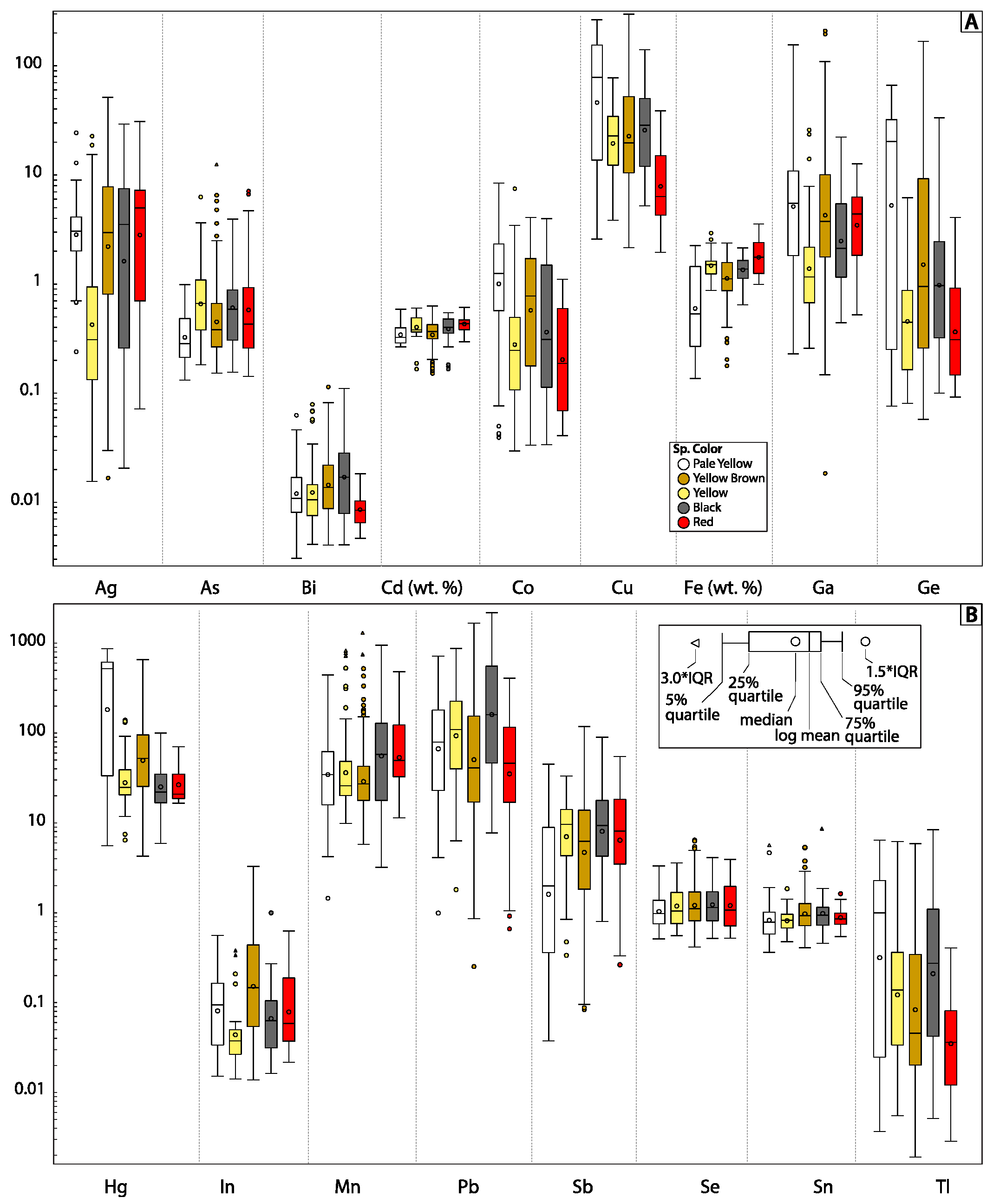
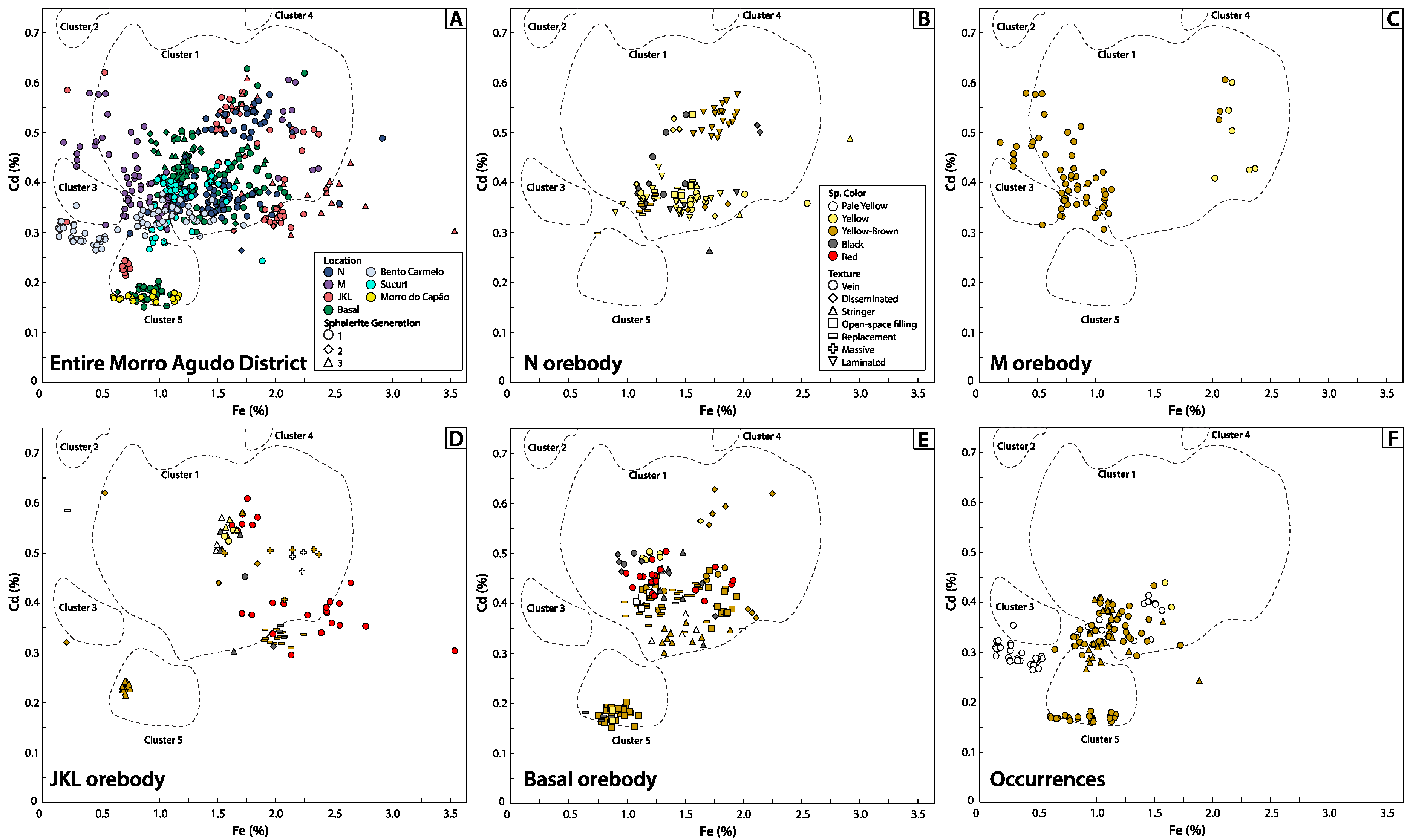
PCA of Sphalerite
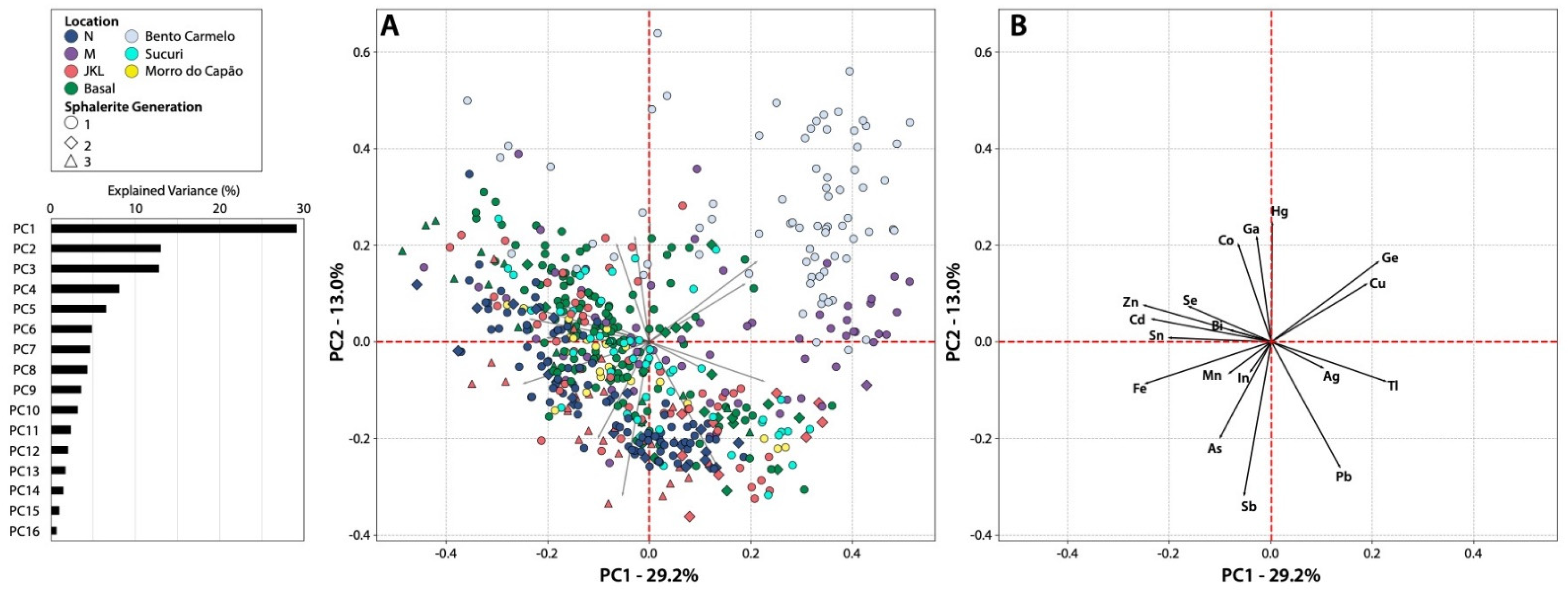
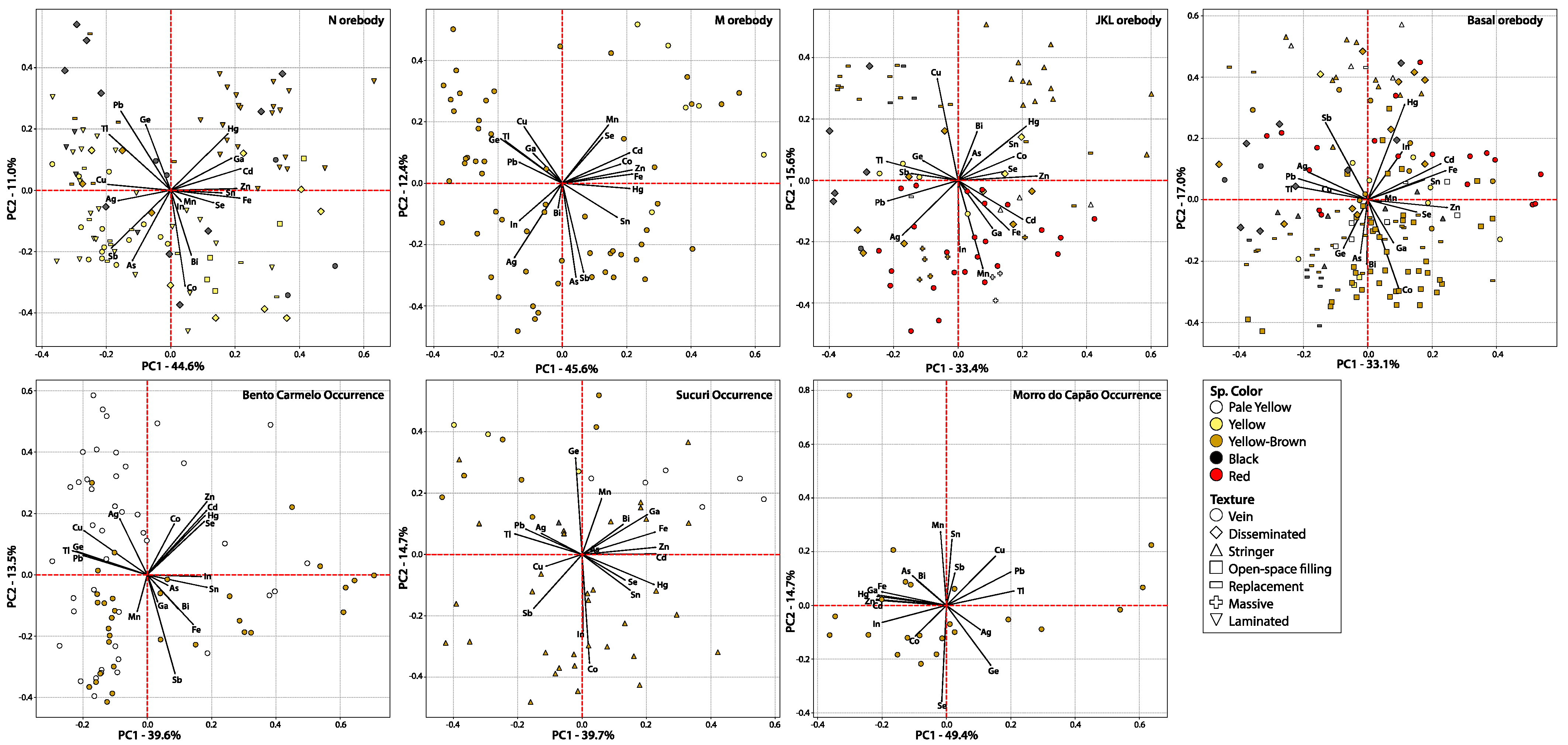
4.2. Galena Trace Element Content
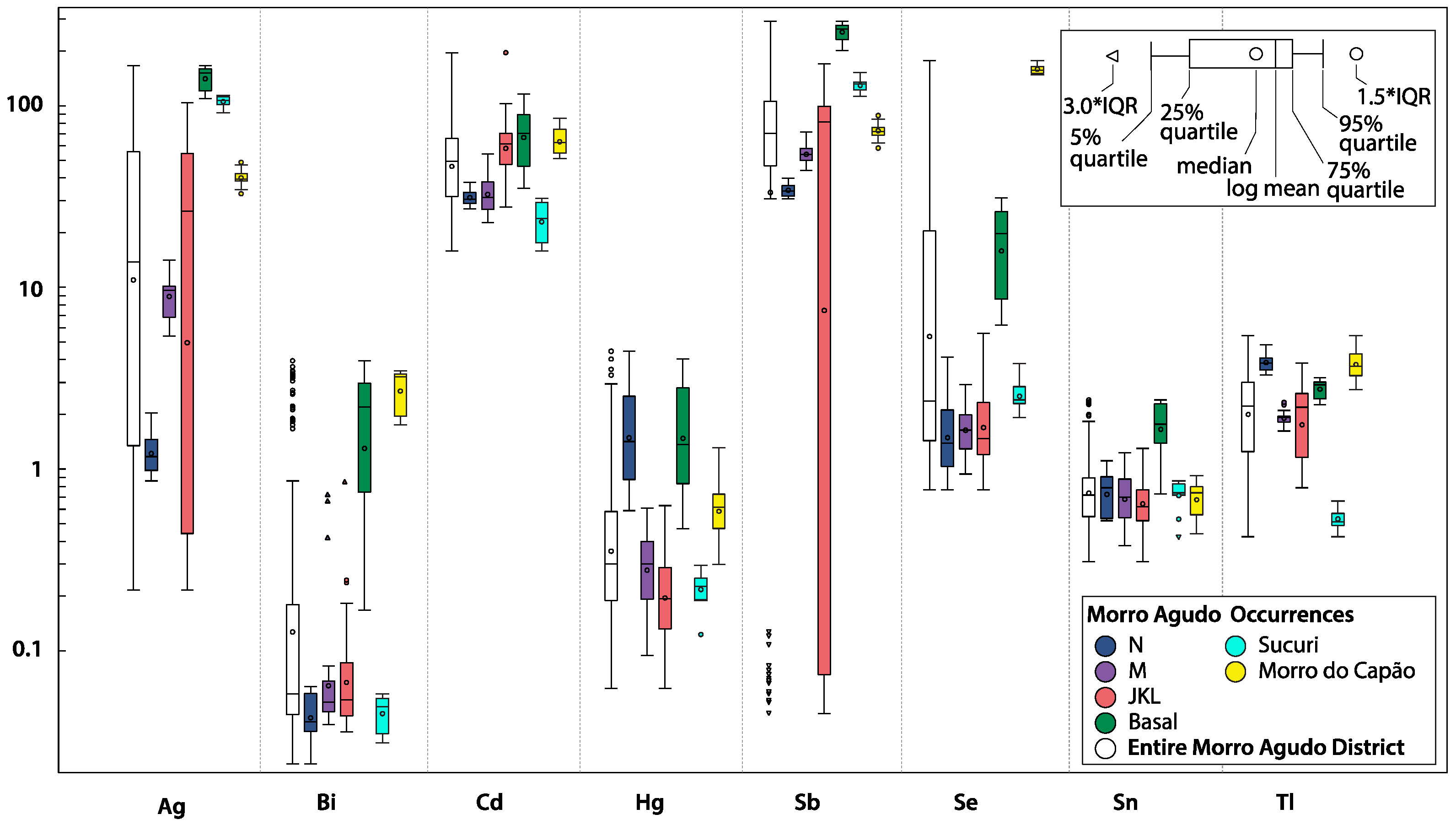
PCA of Galena
5. Discussion
5.1. Ore-Forming Temperatures
5.2. Implications to Ore Genesis in the Morro Agudo District
5.3. Comparison with Vazante-Paracatu Mineral Belt

5.4. Deposit Model
6. Conclusions
- The earliest generations of pale yellow to yellow-brown sphalerite (interpreted as the first generation: Sp-I) have elevated contents of Co, Cu, Ge, Hg, Pb, Tl and lower concentrations of Fe and Mn compared to the red generation of sphalerite (interpreted as the last generation: Sp-III), and the first generation of galena (Gn-I) is enriched in Ag, Cd, and Se and depleted in Cu and Mn relative to the second generation of galena (Gn-II).
- The PCA analysis of sphalerite and galena composition suggests that the mineralizing fluids were associated with two compositions/sources enriched in: (1) Fe, As, In, Mn, Sb, Ag, Tl; and (2) Cd, Bi, Co, Ga, and Se.
- The broad overlap in concentrations between sphalerite generations and locations in the Morro Agudo district suggests the mixing of fluids from these distinct sources. Bento Carmelo is enriched in Cu, Ge, and Hg, which supports previous interpretations that mineralizing processes are derived from unique fluid/sources.
- Sphalerite and galena in the Morro Agudo district have lower concentrations of the trace elements Ag, Cu, Ge and Ag, Cd, Cu, Ga, Ge, and Zn, respectively, compared to sphalerite and galena from other deposits in the Vazante Group.
- The characteristically low Fe, In, and Mn contents in sphalerite from the Morro Agudo district and other Vazante-hosted Zn-Pb sulfide deposits are more similar to MVT deposits than SEDEX or Irish-type deposits.
- Sphalerite geothermometry suggests the Morro Agudo district mineralization formed from fluids with highly variable temperatures ranging from 82 to 320 °C (mean temperatures ~200–250 °C).
- The higher formation temperatures of the Morro Agudo deposits compared to typical MVT deposits may reflect a high geothermal gradient or high advective heat transport caused by the Brasiliano orogeny.
Supplementary Materials
Author Contributions
Funding
Data Availability Statement
Acknowledgments
Conflicts of Interest
References
- Olivo, G.R.; Monteiro, L.; Baia, F.; Slezak, P.; Carvalho, I.; Fernandes, N.; Oliveira, G.; Botura Neto, B.; McGladrey, A.; Silva, A.; et al. The Proterozoic Vazante Hypogene Zinc Silicate District, Minas Gerais, Brazil: A review of the ore system applied to mineral exploration. Minerals 2018, 8, 22. [Google Scholar] [CrossRef]
- Dardenne, M.A.; Freitas-Silva, F.H. Pb–Zn ore deposits of Bambuí and Vazante groups, in the São Francisco Craton and Brasília Fold Belt, Brazil. In Base Metal Deposits of Brazil; Gloria da Silva, M., Misi, A., Eds.; Ernesto von Sperling: Salvador, Brazil, 1999; pp. 75–83. [Google Scholar]
- Dardenne, M.A. The Brasília fold belt. In The Tectonic Evolution of South America, Proceedings of the 31st International Geological Congress, Rio de Janeiro, Brazil, 6–17 August 2000; Cordani, U.G., Milani, E.J., Thomaz Filho, A., Campos, D.A., Eds.; Secretariat Bureau: Rio de Janeiro, Brazil, 2000; pp. 231–263. [Google Scholar]
- Cunha, I.D.A.; Coelho, C.E.S.; Misi, A. Fluid inclusion study of the Morro Agudo Pb-Zn deposit, Minas Gerais, Brazil. Rev. Bras. Geociênc. 2000, 30, 318–321. [Google Scholar] [CrossRef]
- Cunha, I.D.A.; Misi, A.; Babinski, M.; Iyer, S.S.S. Lead isotope constraints on the genesis of Pb-Zn deposits in the Neoproterozoic Vazante Group, Minas Gerais, Brazil. Gondwana Res. 2007, 11, 382–395. [Google Scholar] [CrossRef]
- Monteiro, L.V.S.; Bettencourt, J.S.; Juliani, C.; Oliveira, T.F. Geology, petrography, and mineral chemistry of the Vazante non-sulfide and Ambrósia and Fagundes sulfide-rich carbonate-hosted Zn-(Pb) deposits, Minas Gerais, Brazil. Ore Geol. Rev. 2006, 28, 201–234. [Google Scholar] [CrossRef]
- Monteiro, L.V.S.; Bettencourt, J.S.; Juliani, C.; Oliveira, T.F. Nonsulfide and sulfide-rich zinc mineralizations in the Vazante, Ambrósia and Fagundes deposits, Minas Gerais, Brazil: Mass balance and stable isotope characteristics of the hydrothermal alterations. Gondwana Res. 2007, 11, 362–381. [Google Scholar] [CrossRef]
- Slezak, P.R.; Olivo, G.R.; Oliveira, G.D.; Dardenne, M.A. Geology, mineralogy, and geochemistry of the Vazante Northern Extension zinc silicate deposit, Minas Gerais, Brazil. Ore Geol. Rev. 2014, 56, 234–257. [Google Scholar] [CrossRef]
- McGladrey, A.J.; Olivo, G.R.; Silva, A.M.; Oliveira, G.D.; Neto, B.B.; Perrouty, S. The large integration of physical rock properties, mineralogy, and geochemistry for the exploration of large zinc silicate deposits: A case study of the Vazante zinc deposits, Minas Gerais, Brazil. J. Appl. Geophys. 2017, 136, 400–416. [Google Scholar] [CrossRef]
- Carvalho, I.A.K.; Olivo, G.R.; Moura, M.A.; Oliveira, G.D. Fluid evolution in the southern part of the Proterozoic Vazante Group, Brazil: Implications for exploration of sedimentary-hosted base metal deposits. Ore Geol. Rev. 2017, 91, 588–611. [Google Scholar] [CrossRef]
- Fernandes, N.A.; Olivo, G.R.; Layton-Matthews, D. Siliciclastic-hosted zinc mineralization in the Proterozoic Vazante-Paracatu District, Brazil: Implications for metallogeny and sources of metals in sediment-hosed base metal systems. Ore Geol. Rev. 2019, 114, 103139. [Google Scholar] [CrossRef]
- Fernandes, N.A.; Olivo, G.R.; Layton-Matthews, D.; Voinot, A.; Chipley, D.; Diniz-Oliveira, G. Geochemistry and provenance of siliciclastic rocks from the Mesoproterozoic Upper Vazante Sequence, Brazil: Insights on the evolution of the southwestern margin of the São Francisco Craton and the Columbia Supercontinent. Precambrian Res. 2019, 335, 105483. [Google Scholar] [CrossRef]
- Fernandes, N.A.; Olivo, G.R.; Layton-Matthews, D.; Voinot, A.; Chipley, D.; Leybourne, M.; Reith, W.; Leduc, E.; Diniz-Oliveira, G.; Kyser, T.K. Metal sources in the Proterozoic Vazante-Paracatu sediment-hosted Zn District, Brazil: Constraints from Pb isotope compositions of meta-siliciclastic units. Can. Mineral. 2021, 59, 1187–1205. [Google Scholar] [CrossRef]
- Cevik, I.S.; Olivo, G.R.; Ortiz, J.M. A combined multivariate approach analyzing geochemical data for knowledge discovery: The Vazante-Paracatu Zinc District, Minas Gerais, Brazil. J. Geochem. Expl. 2021, 221, 106696. [Google Scholar] [CrossRef]
- Aldis, C.; Olivo, G.R.; Cevik, I.S.; Arruda, J.A.A.C. Proterozoic Carbonate-hosted Morro Agudo Sulfide Pb-Zn District, Brazil: Mineralogical and Geochemical Evidence of Fluid Mixing during the Ore Stage. Ore Geol. Rev. 2022, 141, 104592. [Google Scholar] [CrossRef]
- Misi, A.; Iyer, S.S.S.; Coelho, C.E.S.; Tassinari, C.C.G.; Franca-Rocha, W.J.S.; Cunha, I.A.; Gomes, A.S.R.; Oliveira, T.F.; Teixeira, J.B.G.; Filho, V.M.C. Sediment hosted lead-zinc deposits of the Neoproterozoic Bambuí Group and correlative sequences, São Francisco Craton, Brazil: A review and a possible metallogenic evolution model. Ore Geol. Rev. 2005, 26, 263–304. [Google Scholar] [CrossRef]
- Cordeiro, P.F.O.; Oliveira, C.G.; Paniago, L.N.; Romagna, G.; Santos, R.V. The carbonate-hosted MVT Morro Agudo Zn-Pb deposit, central Brazil. Ore Geol. Rev. 2018, 101, 437–452. [Google Scholar] [CrossRef]
- Iyer, S.S.S.; Hoefs, J.; Krouse, H.R. Sulfur and Lead isotope geochemistry of galenas from the Bambuí Group, Minas Gerais, Brazil—Implications for ore genesis. Econ. Geol. 1992, 87, 437–443. [Google Scholar] [CrossRef]
- Freitas-Silva, F.H.; Dardenne, M.A. Pb/Pb isotopic patterns of galenas from Morro do Ouro (Paracatu Formation), Morro Agudo/Vazante (Vazante Formation) and Bambuí Group deposits. In Proceedings of the South American Symposium on Isotope Geology, Campos do Jordão, Sao Paulo, Brazil, 15–18 June 1997; pp. 118–120. [Google Scholar]
- Dias, P.H.A.; Sotero, M.P.; Matos, C.A.; Marques, E.D.; Marinho, M.S.; Couto-Júnior, M.A. Área de Relevante Interesse Mineral—ARIM: Distrito Mineral de Paracatu-Unaí (Zn-Pb-Cu), MG: Série Províncias Minerais do Brasil; CPRM-BH: Belo-Horizonte, Brazil, 2018; p. 160. [Google Scholar]
- Cook, N.J.; Ciobanu, C.L.; Pring, A.; Skinner, W.; Shimizu, M.; Danyushevsky, L.; Saini-Eidukat, B.; Melcher, F. Trace and minor elements in sphalerite: A LA-ICP-MS study. Geochim. Cosmochim. Acta 2009, 73, 4761–4791. [Google Scholar] [CrossRef]
- Ye, L.; Cook, N.J.; Ciobanu, C.L.; Yuping, L.; Qian, Z.; Tiegeng, L.; Wei, G.; Yulong, Y.; Danyushevskiy, L. Trace and minor elements in sphalerite from base metal deposits in South China: A LA-ICP-MS study. Ore Geol. Rev. 2011, 39, 188–217. [Google Scholar] [CrossRef]
- Belissont, R.; Boiron, M.-C.; Luais, B.; Cathelineau, M. LA-ICP-MS analyses of minor and trace elements and bulk Ge isotopes in zoned Ge-rich sphalerites from the Noailhic-Saint-Salvy deposit (France): Insights into incorporation mechanisms and ore deposition processes. Geochim. Cosmochim. Acta 2014, 126, 518–540. [Google Scholar] [CrossRef]
- Gagnevin, D.; Menuge, J.F.; Kronz, A.; Barrie, C.; Boyce, A.J. Minor elements in layered sphalerite as a record of fluid origin, mixing and crystallization in the Navan Zn-Pb ore deposit, Ireland. Econ. Geol. 2014, 109, 1513–1528. [Google Scholar] [CrossRef]
- George, L.; Cook, N.J.; Ciobanu, C.L.; Wade, B.P. Trace and minor elements in galena: A reconnaissance LA-ICP-MS study. Am. Mineral. 2015, 100, 548–569. [Google Scholar] [CrossRef]
- George, L.; Cook, N.J.; Ciobanu, C.L. Partitioning of trace elements in co-crystallized sphalerite-galena-chalcopyrite hydrothermal ores. Ore Geol. Rev. 2016, 77, 96–118. [Google Scholar] [CrossRef]
- Frenzel, M.; Hirsch, T.; Gutzmer, J. Gallium, germanium, indium, and other trace and minor elements in sphalerite as a function of ore deposit type—A meta-analysis. Ore Geol. Rev. 2016, 76, 52–78. [Google Scholar] [CrossRef]
- Wei, C.; Huang, Z.; Yan, Z.; Hu, Y.; Ye, L. Trace element contents in sphalerite from the Nayongzhi Zn-Pb Deposit, Northwestern Guizhou, China: Insights into incorporation mechanisms, metallogenic temperature and ore genesis. Minerals 2018, 8, 490. [Google Scholar] [CrossRef]
- Wei, C.; Ye, L.; Hu, Y.; Danyushevsky, L.; Li, Z.; Huang, Z. Distribution and occurrence of Ge and related trace elements in sphalerite from the Lehong carbonate-hosted Zn-Pb deposit, northeastern Yunnan, China: Insights from SEM and LA-ICP-MS studies. Ore Geol. Rev. 2019, 115, 103175. [Google Scholar] [CrossRef]
- Wei, C.; Ye, L.; Hu, Y.; Huang, Z.; Danyushevsky, L.; Wang, H. LA-ICP-MS analyses of trace elements in base metal sulfides from carbonate-hosted Zn-Pb deposits, South China: A case study of the Maoping deposit. Ore Geol. Rev. 2021, 130, 103945. [Google Scholar] [CrossRef]
- Yuan, B.; Zhang, C.; Yu, H.; Yang, Y.; Zhao, Y.; Zhu, C.; Ding, Q.; Zhou, D.; Yang, J.; Xu, Y. Element enrichment characteristics: Insights from the element geochemistry of sphalerite in Daliangzi Pb-Zn deposit, Sichuan, southwest China. J. Geochem. Explor. 2018, 186, 187–201. [Google Scholar] [CrossRef]
- Bauer, M.E.; Burisch, M.; Ostendorf, J.; Krause, J.; Frenzel, M.; Seifert, T.; Gutzmer, J. Trace element geochemistry of sphalerite in contrasting hydrothermal fluid systems of the Freiberg district, Germany: Insights from LA-ICP-MS analysis, near-infrared light microthermometry of sphalerite-hosted inclusions, and sulfur isotope geochemistry. Miner. Depos. 2019, 54, 237–262. [Google Scholar] [CrossRef]
- Cave, B.; Lilly, R.; Hong, W. The effect of co-crystallising sulphides and precipitation mechanisms on sphalerite geochemistry: A case study from the Hilton Zn-Pb(Ag) deposit, Australia. Minerals 2020, 10, 797. [Google Scholar] [CrossRef]
- Knorsch, M.; Nadoll, P.; Klemd, R. Trace elements and textures of hydrothermal sphalerite and pyrite in Upper Permian (Zechstein) carbonates of the North German Basin. J. Geochem. Explor. 2020, 209, 106416. [Google Scholar] [CrossRef]
- Schirmer, T.; Ließmann, W.; Macauley, C.; Felfer, P. Indium and antimony distribution in a sphalerite from the “Burgstaetter Gangzug” of the Upper Harz Mountains Pb-Zn mineralization. Minerals 2020, 10, 791. [Google Scholar] [CrossRef]
- Zhou, L.; Zeng, Q.; Liu, J.; Duan, X.; Sun, G.; Wang, Y.; Chen, P. Tracing mineralization history from the compositional textures of sulfide association: A case study from the Zhenzigou stratiform Zn-Pb deposit, NE China. Ore Geol. Rev. 2020, 126, 103792. [Google Scholar] [CrossRef]
- Hu, Y.; Wei, C.; Ye, L.; Huang, Z.; Danyushevsky, L.; Wang, H. LA-ICP-MS sphalerite and galena trace element chemistry and mineralization-style fingerprinting for carbonate-hosted Pb-Zn deposits: Perspective from early Devonian Huodehong deposit in Yunnan, South China. Ore Geol. Rev. 2020, 136, 104253. [Google Scholar] [CrossRef]
- Qi, Y.; Hu, R.; Gao, J.; Leng, C.; Gao, W.; Gong, H. Trace and minor elements in sulfides from the Lengshuikeng Ag–Pb–Zn deposit, South China: A LA–ICP–MS study. Ore Geol. Rev. 2022, 141, 104663. [Google Scholar] [CrossRef]
- Natural Resources Canada (NRCAN). Critical Minerals. Available online: https://www.nrcan.gc.ca/our-natural-resources/minerals-mining/critical-minerals/23414 (accessed on 1 August 2022).
- Sykes, J.P.; Wright, J.P.; Trench, A. Discovery, supply, and demand: From metals of antiquity to critical metals. Appl. Earth Sci. 2016, 125, 3–20. [Google Scholar] [CrossRef]
- Valeriano, C.M. The Southern Brasília Belt. In The São Francisco Craton, Eastern Brazil: Tectonic Genealogy of a Miniature Continent; Heilbron, M., Cordani, U.G., Alkmim, F.F., Eds.; Springer International Publishing: Cham, Switzerland, 2017; pp. 189–203. [Google Scholar]
- Misi, A.; Azmy, K.; Kaufman, A.J.; Oliveira, T.F.; Sanches, A.L.; Oliveira, G.D. Review of the geological and geochronological framework of the Vazante sequence, Minas Gerais, Brazil: Implications to metallogenic and phosphogenic models. Ore Geol. Rev. 2014, 63, 76–90. [Google Scholar] [CrossRef]
- Fonseca, M.A.; Dardenne, M.A.; Uhlein, A. Faixa Brasília Setor Setentrional: Estilos estruturais e arcabouço tectônico. Rev. Bras. Geociênc. 1995, 25, 267–278. [Google Scholar]
- Azmy, K.; Kendall, B.; Creaser, R.A.; Heaman, L.; de Oliveira, T.F. Global correlation of the Vazante Group, São Francisco Basin, Brazil: Re-Os and U-Pb radiometric age constraints. Precambrian Res. 2008, 164, 160–172. [Google Scholar] [CrossRef]
- Rodrigues, J.B.; Pimentel, M.M.; Buhn, B.; Matteini, M.; Dardenne, M.A.; Alvarenga, C.J.S.; Armstrong, R.A. Provenance of the Vazante Group: New U-Pb, Sm-Nd, Lu-Hf isotopic data and implications for the tectonic evolution of the Neoproterozoic Brasília Belt. Gondwana Res. 2012, 21, 439–450. [Google Scholar] [CrossRef]
- Valeriano, C.M.; Pimentel, M.M.; Heilbron, M.; Almeida, J.C.H.; Trouq, R.A.J. Tectonic evolution of the Brasília Belt, Central Brazil, and early assembly of Gondwana. Geol. Soc. Lond. Spec. Publ. 2008, 294, 197–210. [Google Scholar] [CrossRef]
- Martins-Neto, M.A. Sequence stratigraphic framework of Proterozoic successions in eastern Brazil. Mar. Petrol. Geol. 2009, 26, 163–176. [Google Scholar] [CrossRef]
- Botura Neto, B.; Filho, A.D. Drill core structural analysis and extensional-contractional controls on the sulfide mineralization at the Ambrósia Sul deposit, Vazante Group, Western São Francisco Craton, Brazil. J. Struct. Geol. 2022, 154, 104474. [Google Scholar] [CrossRef]
- Oliver, N.H.S.; Thomson, B.; Freitas-Silva, F.H.; Holcombe, R.J.; Rusk, B.; Almeida, B.S.; Faure, K.; Davidson, G.R.; Esper, E.L.; Guimarães, P.J.; et al. Local and regional mass transfer during thrusting, veining, and boudinage in the genesis of the giant shale-hosted Paracatu gold deposit, Minas Gerais, Brazil. Econ. Geol. 2015, 110, 1803–1834. [Google Scholar] [CrossRef]
- Misi, A.; Iyer, S.S.S.; Tassinari, C.C.G.; Kyle, J.R.; Coelho, C.E.S.; Franca-Rocha, W.J.S.; Gomes, A.S.R.; Cunha, I.A.; Carvalho, I.G. Geological and isotopic constraints on the metallogenic evolution of the Proterozoic sediment-hosted Pb-Zn(-Ag) deposits of Brazil. Gondwana Res. 1999, 2, 47–65. [Google Scholar] [CrossRef]
- Couto, J.G.P.; Cordani, U.G.; Kawashita, K.; Iyer, S.S.S.; Moraes, N.M.P. Consideraçoes, sobre a idade do Grupo Bambuí com Base em análisese isótopicas de Sr e Pb. Rev. Bras. Geociênc. 1981, 11, 5–16. [Google Scholar]
- Wilson, S.A.; Ridley, W.I.; Koenig, A.E. Development of sulfide calibration standards for the laser ablation inductively-coupled plasma mass spectrometry technique. J. Anal. Atom. Spectrom. 2002, 17, 406–409. [Google Scholar] [CrossRef]
- Guillong, M.; Hametner, K.; Reusser, E.; Wilson, S.A.; Günther, D. Preliminary characterisation of new glass reference materials (GSA-1 G, GSC-1 G, GSD-1 G and GSE-1 G) by laser ablation-inductively coupled plasma-mass spectrometry using 193 nm, 213 nm and 266 nm wavelengths. Geostand. Geoanal. Res. 2005, 29, 315–331. [Google Scholar] [CrossRef]
- Norris, A.; Danyushevsky, L. Towards Estimating the Complete Uncertainty Budget of Quantified Results Measured by LA-ICP-MS. In Proceedings of the Goldschmidt, Boston, MA, USA, 8–12 August 2018. [Google Scholar]
- Griffin, W.L.; Powell, W.J.; Pearson, N.J.; O’Reilly, S.Y. GLITTER: Data reduction software for laser ablation ICP-MS. In Laser Ablation ICP-MS in the Earth Sciences: Current Practices and Outstanding Issues, Proceedings of Mineralogical Association of Canada, Vancouver, BC, Canada, 19–20 July 2008; Sylvester, P., Ed.; Mineralogical Association of Canada: Vancouver, BC, Canada, 2008; pp. 308–311. [Google Scholar]
- Van den Boogaart, K.G.; Tolosana-Delgado, R. Analyzing Compositional Data with R, 1st ed.; Springer: Berlin/Heidelberg, Germany; New York, NY, USA, 2013; p. 258. ISBN 978-3-642-36808-0. [Google Scholar]
- Carranza, E.J.M. Analysis and mapping of geochemical anomalies using logratio-transformed stream sediment data with censored values. J. Geochem. Explor. 2011, 110, 167–185. [Google Scholar] [CrossRef]
- Aitchison, J. The Statistical Analysis of Compositional Data. J. R. Stat. Soc. 1982, 40, 139–177. [Google Scholar] [CrossRef]
- Monteiro, L.V.S. Modelamento Metalogenetico dos Depositos de Zinco de Vazante, Fagundes e Ambrósia, Associados ao Grupo Vazante, Minas Gerais. Ph.D. Thesis, Universidade de São Paulo, São Paulo, Brazil, 2002; p. 317. [Google Scholar]
- Wilkinson, J.J. On diagenesis, dolomitisation and mineralisation in the Irish Pb-Zn orefields. Miner. Depos. 2003, 38, 968–983. [Google Scholar] [CrossRef]
- Leach, D.L.; Sangster, D.F.; Kelley, K.D.; Large, R.R.; Garven, G.; Allen, C.R.; Gutzmer, J.; Walters, S. Sediment-Hosted Lead-Zinc Deposits: A Global Perspective. Econ. Geol. 2005, 100, 561–607. [Google Scholar]
- Leach, D.L.; Bradley, D.C.; Huston, D.; Pisarevsky, S.A.; Taylor, R.D.; Gardoll, S.J. Sediment-Hosted Lead-Zinc Deposits in Earth History. Econ. Geol. 2010, 105, 593–625. [Google Scholar] [CrossRef]
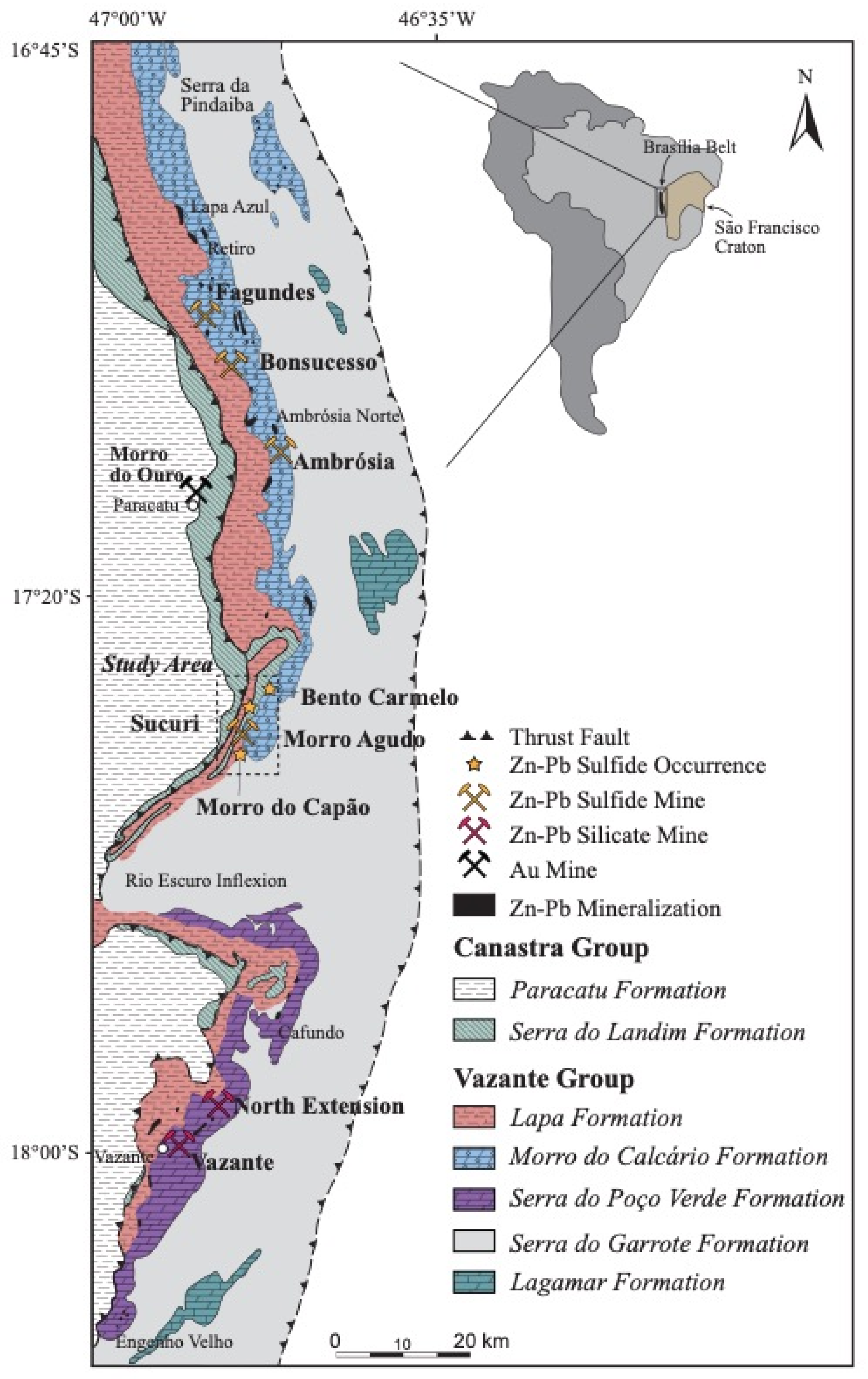
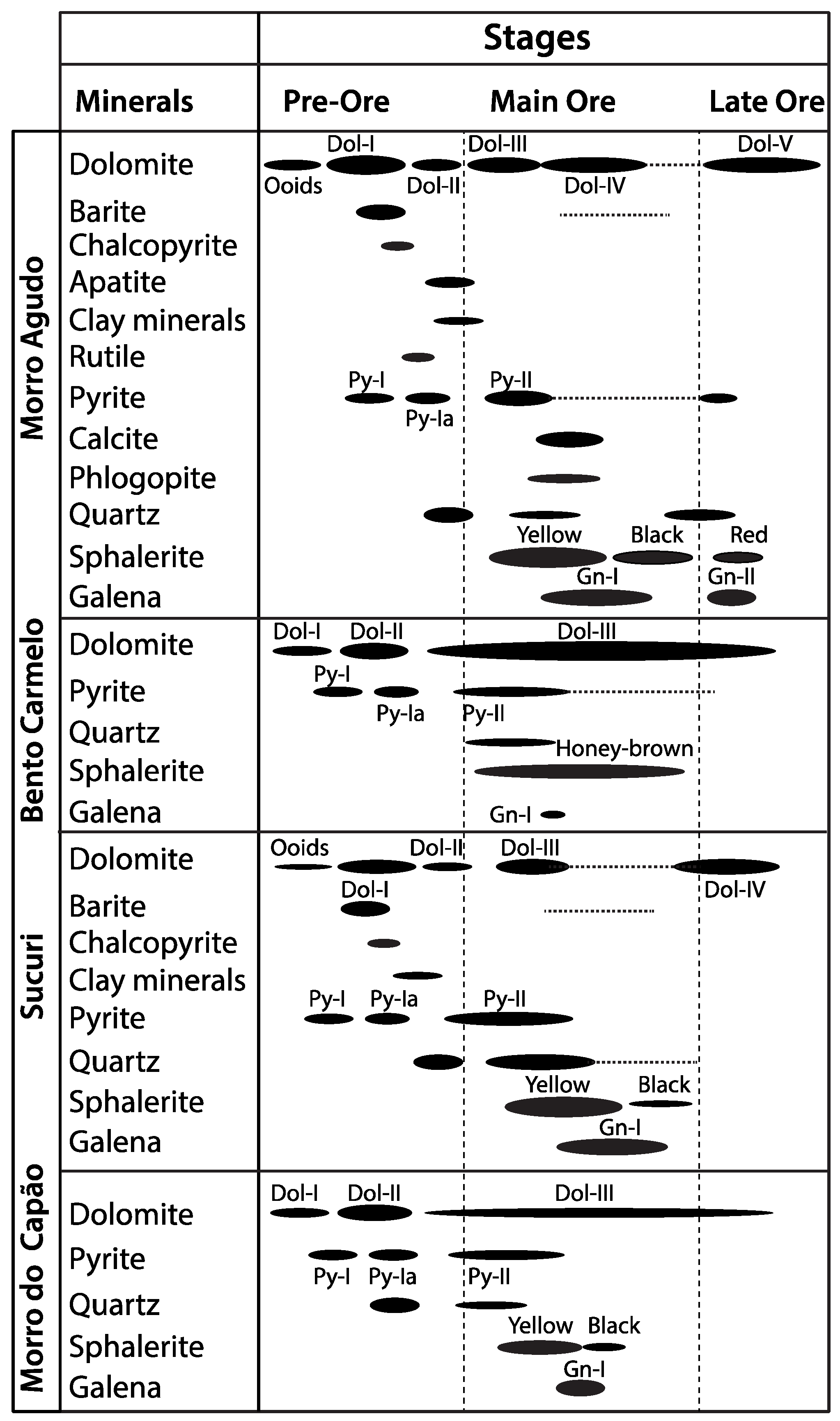
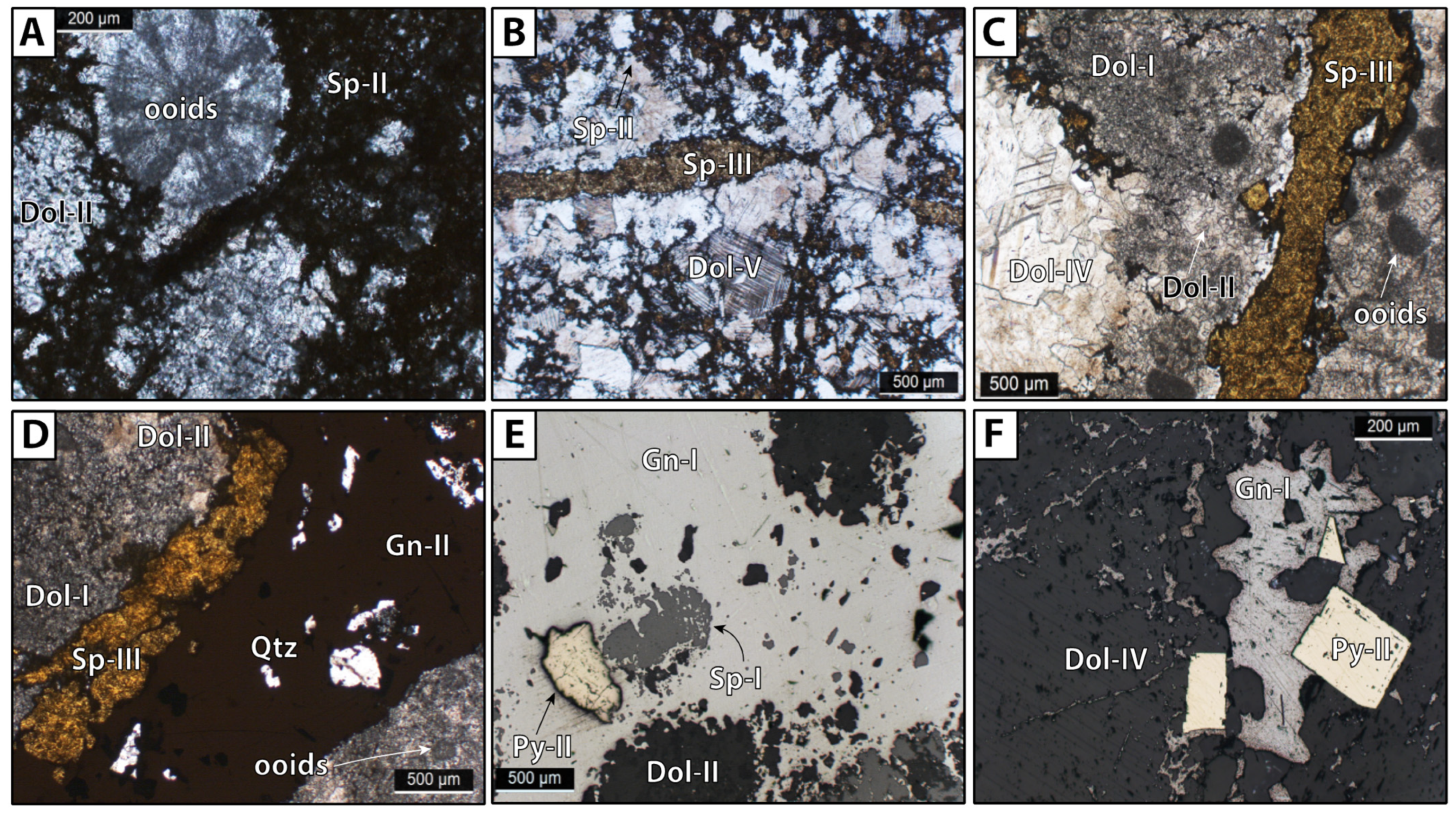

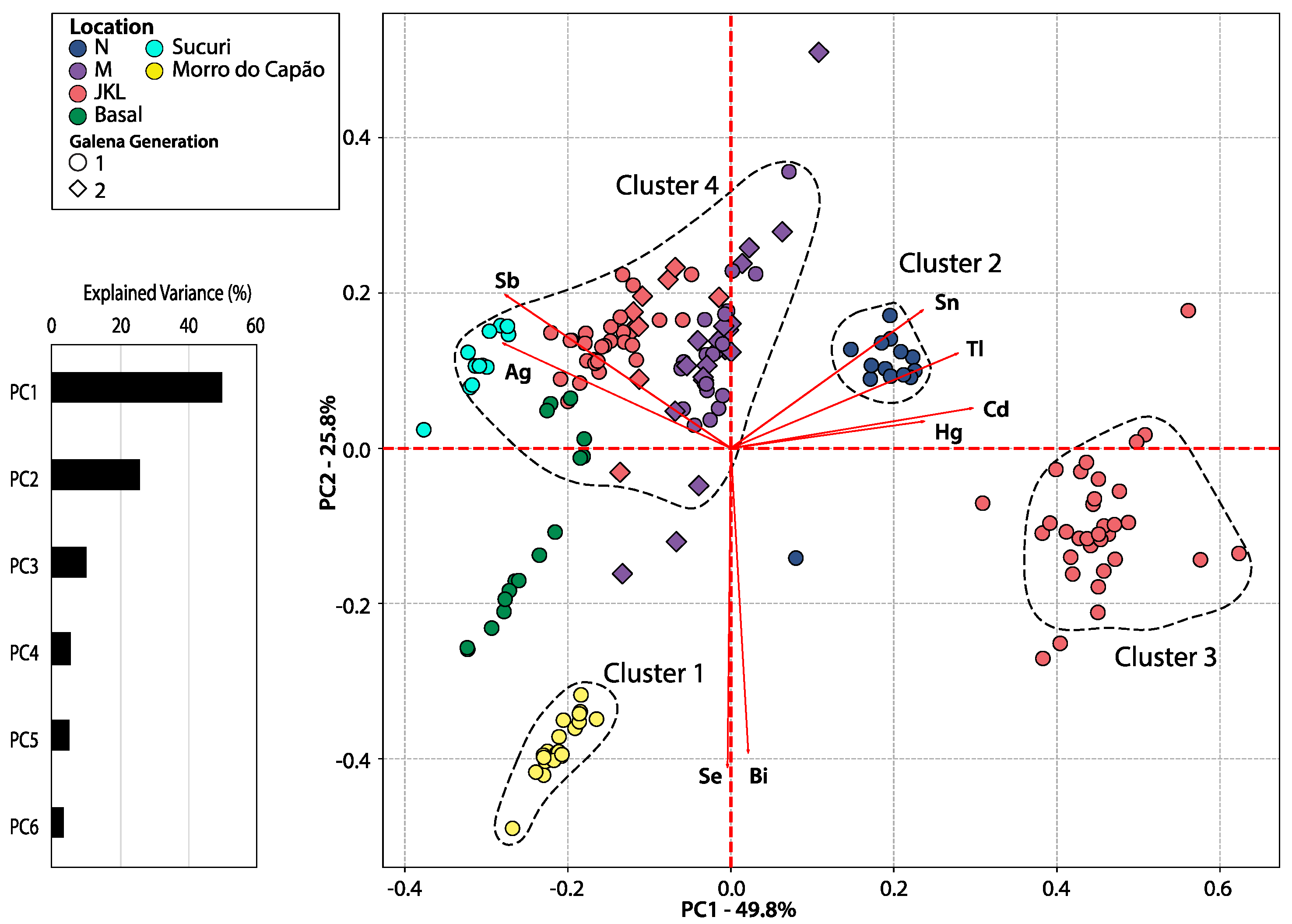

| Type | Basal Orebody | JKL Orebody | M Orebody | N Orebody | Bento Carmelo | Sucuri | Morro do Capão |
|---|---|---|---|---|---|---|---|
| Host Rocks | Dolarenite breccia, dolomite breccia | Dolarenite, dolarenite breccia, dolomite breccia | Dolarenite | Dolarenite | Dolomite | Dolarenite | Dolomite, argillaceous dolomite |
| Sphalerite Textures—By Color | |||||||
| Yellow–Yellow Brown | Breccia, disseminated, massive, cement, veinlets/vein | Massive, cement, brecciated, disseminated, veinlets | Vein, veinlets, massive, disseminated | Laminated, disseminated, massive | Veins/veinlets, stringers, disseminated | Massive, cement, breccia, disseminated, veinlets | Veins/veinlets, stringers, disseminated |
| Black | Disseminated, cement, veinlets/veins | Disseminated, cement, veinlets/veins | Disseminated, veinlets | Disseminated | - | Disseminated, veinlets | Veins/veinlets, stringers, disseminated |
| Red | Veinlets/veins | Veinlets/veins | Veinlets/veins | - | - | - | - |
| Galena Textures—By Generation | |||||||
| 1st | Veins/veinlets, disseminated, breccia | Veins/veinlets, massive, disseminated | Vein, disseminated | Laminated, disseminated | Veinlets | Cement, disseminated, veinlets | Disseminated, open-space fill |
| 2nd | Veins/veinlets, disseminated | Veins/veinlets, disseminated | Vein, disseminated | Disseminated | - | - | - |
| Element | N (n = 108) | M (n = 63) | JKL (n = 88) | Basal (n = 165) | ||||||||||||
|---|---|---|---|---|---|---|---|---|---|---|---|---|---|---|---|---|
| Min. | Max. | Mean | % > LoD | Min. | Max. | Mean | % > LoD | Min. | Max. | Mean | % > LoD | Min. | Max. | Mean | % > LoD | |
| Ag | 0.02 | 0.92 | 0.20 | 95 | 0.15 | 40.2 | 11.4 | 100 | 0.06 | 30.7 | 4.88 | 99 | 0.07 | 51.3 | 5.79 | 100 |
| As | 0.16 | 1.92 | 0.67 | 81 | <0.01 | 12.2 | 0.78 | 63 | 0.01 | 6.62 | 0.74 | 73 | 0.16 | 7.07 | 0.84 | 76 |
| Bi | <0.01 | 0.07 | 0.01 | 65 | <0.01 | 0.04 | 0.02 | 71 | <0.01 | 0.04 | 0.01 | 70 | <0.01 | 0.11 | 0.02 | 88 |
| Cd (%) | 0.26 | 0.58 | 0.41 | 100 | 0.31 | 0.61 | 0.43 | 100 | 0.21 | 0.62 | 0.41 | 100 | 0.15 | 0.63 | 0.38 | 100 |
| Co | 0.03 | 0.93 | 0.22 | 62 | 0.04 | 1.08 | 0.33 | 71 | 0.03 | 0.52 | 0.17 | 77 | 0.03 | 7.46 | 1.67 | 91 |
| Cu | 3.89 | 55.9 | 22.4 | 100 | 5.27 | 199 | 63.9 | 100 | 2.15 | 140 | 23.5 | 100 | 1.94 | 124 | 22.6 | 100 |
| Fe (%) | 0.75 | 2.92 | 1.52 | 100 | 0.18 | 2.37 | 0.96 | 100 | 0.20 | 3.54 | 1.73 | 100 | 0.64 | 2.25 | 1.31 | 100 |
| Ga | 0.25 | 10.1 | 1.50 | 100 | 0.25 | 194 | 20.0 | 100 | 0.43 | 60.7 | 6.11 | 100 | 0.52 | 47.0 | 6.17 | 100 |
| Ge | 0.07 | 2.84 | 0.63 | 62 | 0.12 | 167 | 37.6 | 75 | 0.09 | 33.3 | 2.56 | 81 | 0.06 | 42.7 | 1.93 | 83 |
| Hg | 11.8 | 139 | 46.0 | 100 | 39.6 | 112 | 69.0 | 100 | 5.58 | 107 | 33.1 | 100 | 4.26 | 108 | 34.3 | 100 |
| In | 0.01 | 0.03 | 0.02 | 6 | 0.03 | 3.27 | 0.56 | 90 | 0.02 | 1.06 | 0.18 | 84 | 0.01 | 0.56 | 0.09 | 70 |
| Mn | 11.1 | 935 | 92.0 | 100 | 11.5 | 313 | 38.9 | 100 | 6.40 | 483 | 59.4 | 100 | 3.20 | 949 | 51.4 | 100 |
| Ni | 0.39 | 0.53 | 0.48 | 6 | 0.49 | 7.72 | 1.56 | 17 | 0.46 | 7.21 | 1.27 | 11 | 0.31 | 9.65 | 1.04 | 52 |
| Pb | 10.7 | 1503 | 231 | 100 | 1.59 | 791 | 192 | 100 | 1.26 | 2193 | 212 | 100 | 0.66 | 1843 | 122 | 100 |
| Sb | 0.20 | 23.0 | 7.79 | 100 | 0.09 | 47.0 | 14.5 | 100 | 0.26 | 52.0 | 10.9 | 99 | 0.08 | 118 | 11.0 | 99 |
| Se | 0.47 | 1.77 | 0.92 | 62 | 0.88 | 6.43 | 2.28 | 87 | 0.52 | 1.79 | 0.94 | 58 | 0.44 | 5.46 | 1.55 | 87 |
| Sn | 0.46 | 1.78 | 0.86 | 77 | 0.67 | 3.20 | 1.26 | 56 | 0.51 | 2.16 | 0.94 | 77 | 0.46 | 8.39 | 0.99 | 94 |
| Tl | <0.01 | 5.27 | 0.43 | 96 | <0.01 | 5.87 | 0.67 | 90 | <0.01 | 8.39 | 0.56 | 90 | <0.01 | 4.85 | 0.19 | 93 |
| Element | Sucuri (n = 50) | Bento Carmelo (n = 74) | Morro do Capão (n = 22) | Total Morro Agudo District | ||||||||||||
| Min. | Max. | Mean | % > LoD | Min. | Max. | Mean | % > LoD | Min. | Max. | Mean | % > LoD | Min. | Max. | Mean | % > LoD | |
| Ag | 0.77 | 51.0 | 10.3 | 100 | 0.17 | 5.85 | 2.47 | 100 | 0.05 | 1.57 | 0.46 | 100 | 0.02 | 51.3 | 5.01 | 99 |
| As | 0.19 | 2.48 | 0.56 | 58 | 0.13 | 0.85 | 0.33 | 36 | 0.22 | 0.96 | 0.42 | 68 | 0.13 | 12.2 | 0.74 | 68 |
| Bi | <0.01 | 0.06 | 0.01 | 62 | <0.01 | 0.05 | 0.02 | 78 | <0.01 | 0.02 | 0.01 | 59 | <0.01 | 0.11 | 0.02 | 74 |
| Cd (%) | 0.24 | 0.44 | 0.36 | 100 | 0.26 | 0.38 | 0.32 | 100 | 0.16 | 0.18 | 0.17 | 100 | 0.15 | 0.63 | 0.38 | 100 |
| Co | 0.03 | 2.63 | 1.06 | 72 | 0.08 | 8.42 | 1.76 | 100 | 0.07 | 0.08 | 0.08 | 9 | 0.03 | 8.42 | 1.04 | 78 |
| Cu | 4.60 | 117 | 26.9 | 100 | 5.80 | 297 | 115 | 100 | 9.00 | 163 | 33.1 | 100 | 1.94 | 297 | 40 | 100 |
| Fe (%) | 0.91 | 1.89 | 1.19 | 100 | 0.14 | 1.72 | 0.74 | 100 | 0.60 | 1.17 | 0.90 | 100 | 0.14 | 3.54 | 1.28 | 100 |
| Ga | 1.24 | 10.0 | 3.75 | 100 | 0.02 | 208 | 19.9 | 100 | 2.38 | 5.32 | 3.96 | 100 | 0.02 | 208 | 8.30 | 100 |
| Ge | 0.11 | 60.1 | 4.76 | 60 | 0.12 | 66.1 | 24.9 | 92 | 0.20 | 1.96 | 0.90 | 23 | 0.06 | 167 | 9.64 | 75 |
| Hg | 23.8 | 51.9 | 37.8 | 100 | 212 | 868 | 553 | 100 | 102 | 130 | 116 | 100 | 4.26 | 868 | 111 | 100 |
| In | 0.02 | 1.15 | 0.37 | 98 | 0.02 | 0.31 | 0.07 | 53 | 0.34 | 0.76 | 0.49 | 100 | 0.01 | 3.27 | 0.24 | 64 |
| Mn | 5.78 | 1290 | 82.1 | 100 | 1.45 | 444 | 67.8 | 100 | 5.96 | 59.9 | 19.7 | 100 | 1.45 | 1290 | 62.6 | 100 |
| Ni | - | 1.02 | - | 2 | 0.41 | 4.40 | 1.39 | 61 | - | - | - | 0 | 0.31 | 9.65 | 1.16 | 28 |
| Pb | 4.11 | 1371 | 194 | 100 | 0.25 | 718 | 144 | 100 | 7.59 | 1024 | 134 | 100 | 0.25 | 2193 | 174 | 100 |
| Sb | 0.13 | 33.8 | 7.62 | 100 | 0.04 | 28.4 | 4.29 | 85 | 3.77 | 49.2 | 18.6 | 100 | 0.04 | 118 | 10.0 | 98 |
| Se | 0.41 | 2.89 | 1.30 | 80 | 0.43 | 5.17 | 1.23 | 68 | 0.68 | 1.35 | 0.96 | 45 | 0.41 | 6.43 | 1.39 | 68 |
| Sn | 0.41 | 3.76 | 0.94 | 84 | 0.36 | 5.49 | 1.04 | 95 | 1.08 | 5.37 | 1.97 | 100 | 0.36 | 8.39 | 1.03 | 83 |
| Tl | <0.01 | 6.20 | 0.74 | 90 | <0.01 | 6.44 | 1.88 | 93 | <0.01 | 4.62 | 0.54 | 95 | <0.01 | 8.39 | 0.63 | 93 |
| Element | Pale Yellow (n = 67) | Yellow (n = 85) | Yellow–Brown (n = 323) | |||||||||
|---|---|---|---|---|---|---|---|---|---|---|---|---|
| Min. | Max. | Mean | % > LoD | Min. | Max. | Mean | % > LoD | Min. | Max. | Mean | % > LoD | |
| Ag | 0.24 | 24.2 | 3.64 | 100 | 0.02 | 22.6 | 1.98 | 96 | 0.02 | 51.3 | 5.81 | 99 |
| As | 0.13 | 0.98 | 0.39 | 40 | 0.18 | 6.26 | 0.87 | 81 | 0.15 | 12.2 | 0.66 | 68 |
| Bi | <0.01 | 0.06 | 0.01 | 73 | <0.01 | 0.08 | 0.02 | 65 | <0.01 | 0.11 | 0.02 | 78 |
| Cd (%) | 0.26 | 0.59 | 0.35 | 100 | 0.17 | 0.60 | 0.41 | 100 | 0.15 | 0.63 | 0.36 | 100 |
| Co | 0.04 | 8.42 | 1.93 | 85 | 0.03 | 7.46 | 0.59 | 81 | 0.03 | 4.06 | 1.11 | 72 |
| Cu | 2.57 | 263 | 87.9 | 100 | 3.83 | 77.4 | 23.6 | 100 | 2.15 | 297 | 38.9 | 100 |
| Fe (%) | 0.14 | 2.24 | 0.83 | 100 | 0.87 | 2.92 | 1.51 | 100 | 0.18 | 2.37 | 1.21 | 100 |
| Ga | 0.23 | 155 | 13.7 | 100 | 0.26 | 25.7 | 2.42 | 100 | 0.02 | 208 | 9.90 | 100 |
| Ge | 0.08 | 66.1 | 19.6 | 84 | 0.08 | 6.17 | 0.89 | 71 | 0.06 | 167 | 11.9 | 73 |
| Hg | 5.58 | 868 | 380 | 100 | 6.44 | 139 | 34.1 | 100 | 4.26 | 654 | 99.1 | 100 |
| In | 0.02 | 0.56 | 0.13 | 61 | 0.01 | 0.37 | 0.07 | 28 | 0.01 | 3.27 | 0.31 | 73 |
| Mn | 1.45 | 444 | 60.8 | 100 | 9.86 | 814 | 74.5 | 100 | 5.78 | 1290 | 46.5 | 100 |
| Ni | 0.41 | 3.39 | 1.35 | 54 | 0.43 | 9.65 | 1.90 | 8 | 0.31 | 7.72 | 1.08 | 29 |
| Pb | 1.00 | 718 | 139 | 100 | 1.81 | 872 | 181 | 100 | 0.25 | 1673 | 152 | 100 |
| Sb | 0.04 | 45.1 | 5.48 | 84 | 0.34 | 33.1 | 9.97 | 100 | 0.08 | 118 | 9.71 | 99 |
| Se | 0.51 | 3.31 | 1.15 | 63 | 0.56 | 3.58 | 1.36 | 65 | 0.41 | 6.43 | 1.43 | 76 |
| Sn | 0.36 | 5.49 | 0.97 | 94 | 0.48 | 1.85 | 0.85 | 66 | 0.41 | 5.37 | 1.08 | 85 |
| Tl | <0.01 | 6.44 | 1.41 | 93 | 0.01 | 6.20 | 0.39 | 88 | <0.01 | 5.87 | 0.54 | 92 |
| Element | Black (n = 52) | Red (n = 43) | ||||||||||
| Min. | Max. | Mean | % > LoD | Min. | Max. | Mean | % > LoD | |||||
| Ag | 0.02 | 29.2 | 5.51 | 98 | 0.07 | 30.8 | 6.38 | 100 | ||||
| As | 0.16 | 3.93 | 0.88 | 87 | 0.14 | 7.07 | 1.19 | 63 | ||||
| Bi | <0.01 | 0.11 | 0.02 | 81 | <0.01 | 0.02 | 0.01 | 58 | ||||
| Cd (%) | 0.17 | 0.54 | 0.40 | 100 | 0.30 | 0.61 | 0.44 | 100 | ||||
| Co | 0.03 | 3.96 | 0.86 | 81 | 0.04 | 1.10 | 0.33 | 95 | ||||
| Cu | 5.19 | 140 | 36.6 | 100 | 1.94 | 38.5 | 11.0 | 100 | ||||
| Fe (%) | 0.64 | 2.14 | 1.40 | 100 | 0.99 | 3.54 | 1.84 | 100 | ||||
| Ga | 0.44 | 22.1 | 4.12 | 100 | 0.52 | 12.6 | 4.46 | 100 | ||||
| Ge | 0.10 | 33.3 | 2.87 | 79 | 0.09 | 4.07 | 0.60 | 77 | ||||
| Hg | 5.92 | 100 | 31.5 | 100 | 16.57 | 70.3 | 29.4 | 100 | ||||
| In | 0.02 | 1.00 | 0.12 | 42 | 0.02 | 0.63 | 0.13 | 95 | ||||
| Mn | 3.20 | 949 | 129 | 100 | 11.37 | 483 | 81.6 | 100 | ||||
| Ni | 0.39 | 3.68 | 0.92 | 33 | 0.42 | 2.24 | 1.30 | 12 | ||||
| Pb | 7.73 | 2193 | 421 | 100 | 0.66 | 408 | 79.0 | 100 | ||||
| Sb | 0.80 | 89.6 | 14.6 | 100 | 0.26 | 54.8 | 12.4 | 100 | ||||
| Se | 0.52 | 4.11 | 1.44 | 73 | 0.52 | 3.91 | 1.44 | 79 | ||||
| Sn | 0.46 | 8.39 | 1.16 | 90 | 0.54 | 1.63 | 0.91 | 79 | ||||
| Tl | 0.01 | 8.39 | 1.01 | 98 | <0.01 | 0.41 | 0.07 | 91 | ||||
| Elements | Basal (n = 16) | JKL (n = 69) | M (n = 39) | |||||||||
|---|---|---|---|---|---|---|---|---|---|---|---|---|
| Min. | Max. | Mean | % > LoD | Min. | Max. | Mean | % > LoD | Min. | Max. | Mean | % > LoD | |
| Ag | 109 | 166 | 142 | 100 | 0.22 | 104 | 26.6 | 100 | 5.38 | 14.1 | 9.16 | 100 |
| Bi | 0.17 | 3.95 | 1.94 | 100 | 0.04 | 0.85 | 0.08 | 100 | 0.04 | 0.71 | 0.10 | 100 |
| Cd | 35.2 | 116 | 71.5 | 100 | 27.7 | 196 | 61.4 | 100 | 22.7 | 54.3 | 33.5 | 100 |
| Cu | - | - | - | - | - | - | - | - | 0.44 | 3.83 | 1.46 | 77 |
| Fe | 4.76 | 90.3 | 23.4 | 56 | - | - | - | - | - | - | - | - |
| Ge | 0.05 | 0.13 | 0.09 | 50 | - | - | - | - | - | - | - | - |
| Hg | 0.47 | 4.03 | 1.80 | 100 | 0.06 | 0.63 | 0.23 | 93 | 0.09 | 0.61 | 0.31 | 100 |
| Mn | - | - | - | - | 0.09 | 310 | 25.6 | 58 | 0.10 | 119 | 10.7 | 64 |
| Sb | 201 | 292 | 256 | 100 | 0.05 | 170 | 65.9 | 81 | 44.0 | 71.7 | 54.3 | 100 |
| Se | 6.19 | 31.1 | 18.1 | 100 | 0.77 | 5.57 | 1.88 | 48 | 0.94 | 2.92 | 1.71 | 49 |
| Sn | 0.73 | 2.4 | 1.74 | 100 | 0.31 | 1.30 | 0.68 | 84 | 0.38 | 1.23 | 0.71 | 95 |
| Tl | 2.26 | 3.18 | 2.77 | 100 | 0.79 | 3.82 | 1.93 | 100 | 1.62 | 2.33 | 1.91 | 100 |
| Elements | N (n = 14) | Sucuri (n = 12) | Morro do Capão (n = 20) | |||||||||
| Min. | Max. | Mean | % > LoD | Min. | Max. | Mean | % > LoD | Min. | Max. | Mean | % > LoD | |
| Ag | 0.86 | 2.04 | 1.26 | 100 | 91.0 | 114 | 106 | 100 | 32.8 | 48.8 | 40.3 | 100 |
| Bi | 0.02 | 0.06 | 0.04 | 100 | 0.03 | 0.06 | 0.05 | 100 | 1.75 | 3.47 | 2.78 | 100 |
| Cd | 27.0 | 37.8 | 31.4 | 100 | 15.9 | 30.9 | 23.6 | 100 | 51.2 | 85.2 | 64.1 | 100 |
| Cu | - | - | - | - | 0.02 | 1.87 | 0.50 | 67 | 0.25 | 3.64 | 1.54 | 65 |
| Fe | - | - | - | - | - | - | - | - | - | - | - | - |
| Ge | - | - | - | - | - | - | - | - | 0.37 | 0.61 | 0.50 | 100 |
| Hg | 0.59 | 4.45 | 1.77 | 100 | 0.12 | 0.30 | 0.22 | 100 | 0.30 | 1.31 | 0.62 | 100 |
| Mn | 0.07 | 3.75 | 0.69 | 86 | - | - | - | - | - | - | - | - |
| Sb | 30.6 | 39.8 | 34.3 | 100 | 113 | 152 | 130 | 100 | 58.5 | 88.2 | 73.1 | 100 |
| Se | 1.92 | 4.12 | 1.66 | 86 | 1.92 | 3.80 | 2.56 | 100 | 148 | 177 | 159 | 100 |
| Sn | 0.52 | 1.11 | 0.75 | 93 | 0.42 | 0.86 | 0.73 | 92 | 0.44 | 0.92 | 0.69 | 95 |
| Tl | 3.29 | 4.82 | 3.88 | 100 | 0.42 | 0.67 | 0.54 | 100 | 2.74 | 5.41 | 3.82 | 100 |
| Elements | 1st (n = 141) | 2nd (n = 29) | ||||||
|---|---|---|---|---|---|---|---|---|
| Min. | Max. | Mean | % > LoD | Min. | Max. | Mean | % > LoD | |
| Ag | 0.22 | 166 | 43.1 | 100 | 6.69 | 35.5 | 16.4 | 100 |
| Bi | 0.02 | 3.95 | 0.66 | 100 | 0.04 | 0.85 | 0.14 | 100 |
| Cd | 15.9 | 116 | 52.6 | 100 | 25.2 | 196 | 44.3 | 100 |
| Cu | 0.28 | 4.31 | 1.34 | 44 | 0.29 | 2.49 | 1.11 | 69 |
| Fe | - | - | - | - | - | - | - | - |
| Ge | 0.04 | 0.61 | 0.37 | 32 | 0.05 | 0.06 | 0.06 | 12 |
| Hg | 0.07 | 4.45 | 0.64 | 96 | 0.06 | 0.61 | 0.29 | 100 |
| Mn | 0.07 | 310 | 14.1 | 50 | 0.10 | 183 | 20.0 | 55 |
| Sb | 0.05 | 292 | 90.3 | 91 | 44.7 | 94.4 | 63.4 | 100 |
| Se | 0.77 | 177 | 37.0 | 70 | 0.97 | 2.92 | 1.81 | 52 |
| Sn | 0.31 | 2.40 | 0.82 | 90 | 0.41 | 1.23 | 0.76 | 93 |
| Tl | 0.42 | 5.41 | 2.31 | 100 | 1.80 | 3.83 | 2.21 | 100 |
| Orebody/Occurrence (n) | Estimate Temperature (°C) | ||||
|---|---|---|---|---|---|
| Min. | Max. | Mean | Mode | Std. Dev. | |
| N (108) | 186 | 320 | 247 | 240–246 | 21 |
| M (63) | 113 | 294 | 193 | 213–222 | 46 |
| JKL (88) | 119 | 297 | 234 | 226–235 | 31 |
| Basal (165) | 147 | 297 | 227 | 222–230 | 28 |
| Bento Carmelo (74) | 82 | 262 | 168 | 199–208 | 43 |
| Sucuri (50) | 167 | 294 | 238 | 237–244 | 25 |
| Morro do Capão (22) | 222 | 294 | 240 | 237–240 | 15 |
| Sphalerite Color (n) | Estimate Temperature (°C) | ||||
| Min. | Max. | Mean | Mode | Std. Dev. | |
| Pale Yellow (67) | 82 | 297 | 187 | 233–243 | 58 |
| Yellow (85) | 175 | 320 | 243 | 241–248 | 26 |
| Yellow-Brown (323) | 113 | 294 | 219 | 231–240 | 37 |
| Black (52) | 157 | 293 | 232 | 225–239 | 28 |
| Red (43) | 214 | 292 | 249 | 230–234 | 18 |
| Orebody | Estimate Temperature (°C)—Cunha et al. (2000) | ||||
| Block (n) | Min. | Max. | Mode. | ||
| N | C (16) | 120 | 150 | 135 | |
| M | A (74) | 100 | 164 | 135 | |
| JKL | A (153) | 100 | 300 | 165 | |
| B (15) | 140 | 160 | 155 | ||
| C (65) | 80 | 170 | 155 | ||
| Basal | B (24) | 80 | 210 | 165 | |
| Mineral | Deposit | Ag | Cd | Co | Cu | Fe | Ga | Ge | Mn | Zn |
|---|---|---|---|---|---|---|---|---|---|---|
| Galena | Ambrósia | 140 | 420 | - | - | - | 3340 | 7010 | - | 1610 |
| Fagundes | 170 | 420 | - | - | - | 3470 | 4970 | - | 740 | |
| Vazante | 230 | 710 | - | - | - | 120 | 380 | - | 3920 | |
| Morro Agudo | 71 | - | - | 41 | - | 10 | - | - | - | |
| Sphalerite | Ambrósia | 120 | 1190 | - | - | 0.78 | - | 300 | - | - |
| Fagundes | 210 | 3350 | - | 300 | 0.46 | - | 540 | - | - | |
| Vazante | 120 | 8410 | - | 240 | 0.09 | - | 130 | - | - | |
| Morro Agudo | 20 | 7700 | 10 | 72 | 0.64 | 10 | - | 825 | - |
Publisher’s Note: MDPI stays neutral with regard to jurisdictional claims in published maps and institutional affiliations. |
© 2022 by the authors. Licensee MDPI, Basel, Switzerland. This article is an open access article distributed under the terms and conditions of the Creative Commons Attribution (CC BY) license (https://creativecommons.org/licenses/by/4.0/).
Share and Cite
Aldis, C.; Olivo, G.R.; Morfin, S. LA-ICP-MS Trace Element Composition of Sphalerite and Galena of the Proterozoic Carbonate-Hosted Morro Agudo Zn-Pb Sulfide District, Brazil: Insights into Ore Genesis. Minerals 2022, 12, 1028. https://doi.org/10.3390/min12081028
Aldis C, Olivo GR, Morfin S. LA-ICP-MS Trace Element Composition of Sphalerite and Galena of the Proterozoic Carbonate-Hosted Morro Agudo Zn-Pb Sulfide District, Brazil: Insights into Ore Genesis. Minerals. 2022; 12(8):1028. https://doi.org/10.3390/min12081028
Chicago/Turabian StyleAldis, Colin, Gema R. Olivo, and Samuel Morfin. 2022. "LA-ICP-MS Trace Element Composition of Sphalerite and Galena of the Proterozoic Carbonate-Hosted Morro Agudo Zn-Pb Sulfide District, Brazil: Insights into Ore Genesis" Minerals 12, no. 8: 1028. https://doi.org/10.3390/min12081028
APA StyleAldis, C., Olivo, G. R., & Morfin, S. (2022). LA-ICP-MS Trace Element Composition of Sphalerite and Galena of the Proterozoic Carbonate-Hosted Morro Agudo Zn-Pb Sulfide District, Brazil: Insights into Ore Genesis. Minerals, 12(8), 1028. https://doi.org/10.3390/min12081028






